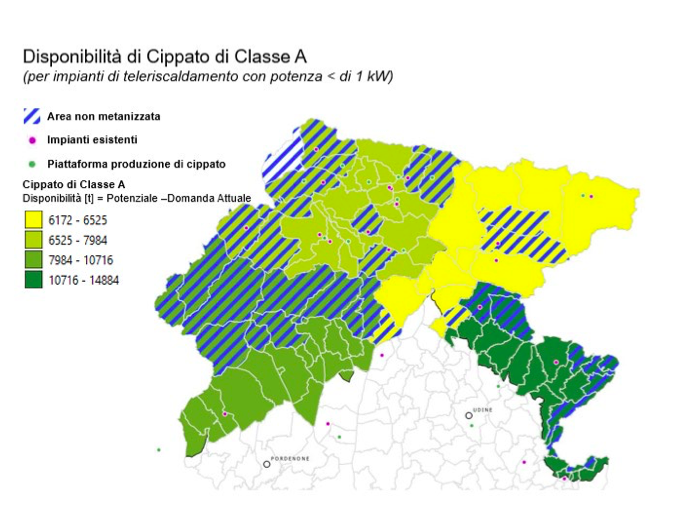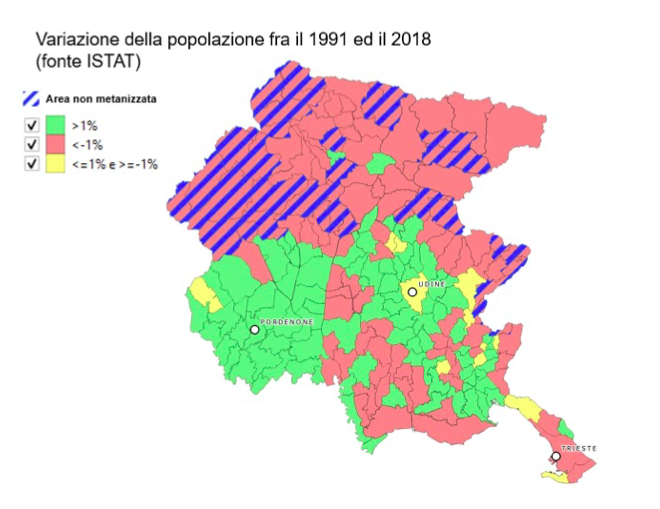Italy
Ongoing
- Type : Energy planning
- Size : Regional
- Area : Industrial, Residential, Utility
Environmental benefit
Regional Action Plan – Friuli Venezia Giulia
Share
Italy
Ongoing
- Type : Energy planning
- Size : Regional
- Area : Industrial, Residential, Utility
Environmental benefit
Discover this use case online


Results of the analysis of the RES potential in the Autonomous Region of Friuli Venezia Giulia show that forest biomass is the most interesting energy source to foster the development and diffusion of small RES DH networks at regional level.
What emerged is in line with the objectives of ENTRAIN project which aims at the diffusion of this type of networks, integrated where possible with other renewable sources, planned, built and managed according to the “QM Holzheizwerke” quality system. This quality standard, associated with the local availability of wood biomass, is the best condition for guaranteeing high energy performance, high profitability, low environmental impact, job opportunities for local businesses and improving air quality.
From the analysis of the different maps developed with GIS software, it was possible to highlight the areas in which the diffusion of small district heating networks could be favored and that are characterized by the coincidence of the following three requirements:
1) availability of class A wood chips, as this is the type that is used in small district heating networks,
2) presence of logistics platforms for nearby forest biomass;
3) not reached by the grid.
In the territories where the aforementioned requirements are met, demographic trends will also be analysed thanks to a dedicated map developed with a GIS-based software.
The strategy is also inspired by the analysis of the weaknesses and strengths of the national and regional scenario of the wood biomass sector.
 R-ACES has received funding from the European Union’s Horizon 2020 research and innovation programme under grant agreement N° 892429
R-ACES has received funding from the European Union’s Horizon 2020 research and innovation programme under grant agreement N° 892429
Results of the analysis of the RES potential in the Autonomous Region of Friuli Venezia Giulia show that forest biomass is the most interesting energy source to foster the development and diffusion of small RES DH networks at regional level.
What emerged is in line with the objectives of ENTRAIN project which aims at the diffusion of this type of networks, integrated where possible with other renewable sources, planned, built and managed according to the “QM Holzheizwerke” quality system. This quality standard, associated with the local availability of wood biomass, is the best condition for guaranteeing high energy performance, high profitability, low environmental impact, job opportunities for local businesses and improving air quality.
From the analysis of the different maps developed with GIS software, it was possible to highlight the areas in which the diffusion of small district heating networks could be favored and that are characterized by the coincidence of the following three requirements:
1) availability of class A wood chips, as this is the type that is used in small district heating networks,
2) presence of logistics platforms for nearby forest biomass;
3) not reached by the grid.
In the territories where the aforementioned requirements are met, demographic trends will also be analysed thanks to a dedicated map developed with a GIS-based software.
The strategy is also inspired by the analysis of the weaknesses and strengths of the national and regional scenario of the wood biomass sector.
